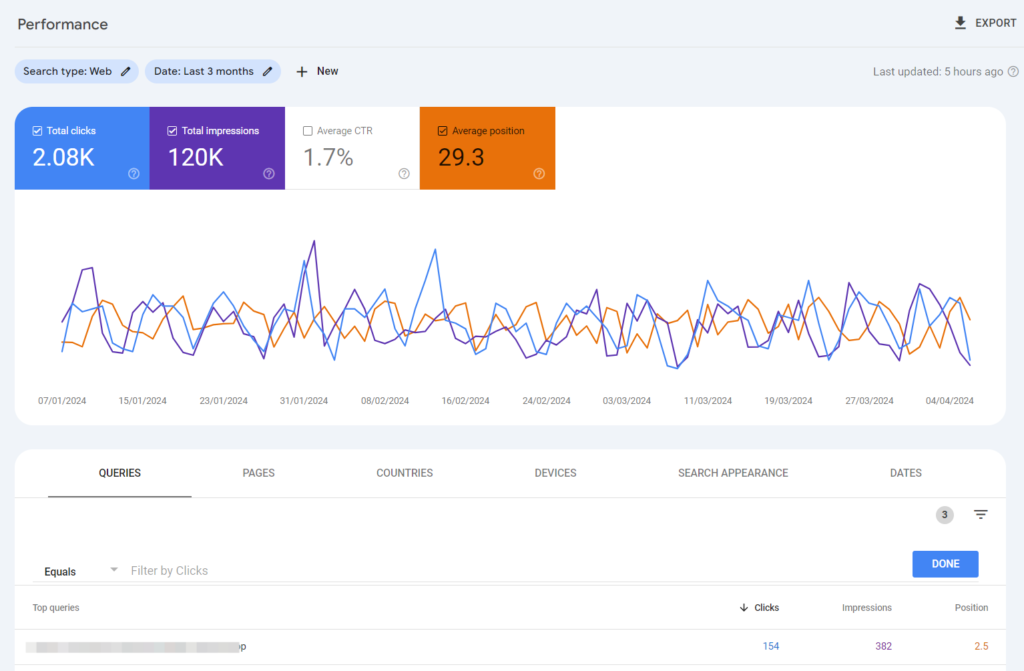Often, a client of SEO services does not quite clearly understand what exactly they should be paying the contractor for. A clearly defined KPI can help avoid misunderstandings. However, it’s important to properly formulate it and, most importantly, to be able to explain it to your potential client.
The most important quality for an SEO specialist’s KPI should be transparency. The client may have an entirely different understanding of how the optimization budget will be implemented and what results will be achieved, and most importantly—when this will happen. To make the KPI transparent, it’s necessary to carefully select which parameter you will be tracking when evaluating the promotion of a given project.
For instance, it is not always appropriate to choose traffic growth as the primary KPI. With a steady growth of the site in search results—which can be a good indicator of the effectiveness of the chosen strategy—traffic growth can be minimal. The client may feel that the SEO budget is being wasted. To avoid such a situation, it might be wiser to choose another indicator to assess the effectiveness of the promotion, such as the growth of positions over specific periods.
Criteria for Evaluating SEO Work
The choice of KPI evaluation parameters should be made individually for each site. Nevertheless, there are some options that are most commonly used and deserve special attention.
Traffic This indicator is one of the key measures of a site’s success. In theory, the better the SEO-specialist works, the more users visit the resource. Traffic is convenient because it is very easy to track—the statistics will be precise and specific. Unlike the promotion of queries—where some may improve positions while others remain unchanged or even worsen—traffic will grow regardless of which pages are being promoted.
However, it’s important to remember that in some cases, traffic growth will be small until a certain point. If you agree with the client to promote a small number of pages and queries, and evaluate progress by the number of visits, then it is highly likely that no effect will be noted. You risk facing misunderstanding, as the effect of your actions will not be visible. This is also possible if you do not monitor traffic for specific queries—which should be agreed upon separately.
There may be situations where your client does not need an increase in visits at all. For example, if you are promoting a successful brand’s website, it may already have a sufficient level of transitions directly through brand queries. In such a case, the SEO tasks for such resources will be different.
Conversion In most cases—especially if you are promoting a commercial site—conversion will be one of the key indicators. The owner cares not only about visits but also about the actions of visitors: registrations, orders, purchases. The higher the conversion rate, that is, the more visitors perform target actions as a result of the SEO-specialist’s work, the higher their actions are valued. This is true not only for the entire site as a whole but also for individual pages. Those that have undergone reworking and optimization should demonstrate an increase in conversion. If this does not happen, the work can hardly be considered effective.
If you agree with the client to include the conversion rate in your KPI, make sure in advance that the task is feasible. You may not achieve significant growth for reasons beyond your control, such as the overall market situation or in a particular product niche, and the client will be dissatisfied. The problem in this case will be entirely on your side, as you have taken on a task that is inherently unsolvable.
Visibility The effectiveness of SEO work is often measured by visibility. This is the percentage of the site’s target audience that sees it in search engine results. Growth or decline in visibility indicates the effectiveness of promotion or vice versa. Data on visibility can be collected in services like Megaindex and Serpstat.
Positions Overall, changes in positions in one direction or another allow for a fairly objective conclusion about whether the SEO-specialist is acting correctly. Uniform growth usually indicates the correctness of the approach. Stagnation, sporadic increases in indicators, or their decline suggest the opposite. The indicator can be tracked in Google Search Console (GSC).

Content Dynamics Report in Search Results
It is important to consider the total number of queries for which the site is growing. SEO tools allow for accurate selection of key phrases to attract traffic. You need to agree with the client in advance on the percentage of the total mass of these phrases that needs to be brought to the top-1, top-3, top-5, or top-10 within a specified period for the promotion to be considered successful.
Trust
Various trust indicators, such as Ahrefs’ DR or MOZ` DA, are known criteria for site quality—the higher they are, the more trust the resource deserves. You can promise the client to increase these and ask to consider this criterion in your KPI. However, this decision is not entirely honest, and a client who is even slightly familiar with search engine optimization is unlikely to agree to this for two reasons.
Firstly, there are proven and effective methods for boosting trust. Thus, the indicator will grow, but the actual quality of the site will not improve. Secondly, the growth of these indicators does not directly bring significant benefits, although they do affect, for example, positions in search results. Thus, the client will pay you for achieving an ambiguous result.
Behavioral Factors
Traffic is heterogeneous, so not all of it is equally good for the site. For example, the depth of view plays a big role—users who visit several pages in one session are more valuable. Perhaps it is this factor by which you will evaluate the effectiveness of promotion. Google Analytics service allows you to track such information accurately.
You can also monitor how often rejections occur—when visitors leave the page without waiting for it to load. Often, SEO work implies reducing the percentage of rejections, especially for old and unoptimized sites. KPI may include increasing the number of clicks on the site’s snippet in search results—CTR.
However, KPI is rarely based solely on the assessment of behavioral factors. If the client is familiar with the specifics of site promotion, they may know that these can be easily manipulated, so growth will not be synonymous with effective promotion. Nevertheless, such an assessment can also be used to determine the quality of a specialist’s work.
Financial Indicators
This category includes several indicators that can also be included in your KPI. Any client is interested in reducing costs and getting the maximum return as a result. Therefore, if the cost per lead (CPL) and the cost of attracting users (CPC) decrease during optimization, and the return on investment (ROI) increases, this indicates quality work done.
If you are confident that your actions will lead to the client spending less money on attracting the target audience and their revenues will increase, then these indicators can also be added to your KPI.
How to Form an Objective KPI
If you strive to build a trustful relationship with a client, the KPI must be formed in a way that objectively reflects the results you plan to achieve during the promotion. There is no universal solution here, as each site is promoted differently, and each SEO-specialist has their own methods. However, there are some trends to follow in most cases.
Objectivity is not synonymous with comprehensiveness. Do not try to include as many different indicators as possible in the KPI. Most likely, such a decision will lead to the site owner not getting an adequate understanding of how the site promotion work is going, and you will not be able to get the deserved reward for your efforts and time.
From the very beginning, define what tasks you need to accomplish. For example, if we’re talking about a commercial site, agree on which goal is a priority: increasing traffic or conversions. At the same time, it is necessary to specify exactly what conversions are being discussed, as there can also be misunderstandings here—registration on the site is also a traffic conversion, but at the same time, the user may not buy anything later. You should also specify just as concretely which tools you will use to evaluate the indicators—ideally, monitoring should be carried out in automatic mode.
It is especially important to clearly define the deadlines for fulfilling your obligations, the reporting periods, and the order in which you will carry out SEO work. If in the process you realize that the initial plan requires adjustments, you need to inform the client as soon as possible to agree on changes to the KPI in advance.
Following these recommendations, you can make your relationship with the client as transparent as possible, and your effectiveness will be assessed on specific indicators without ambiguity and any opportunities to reconsider existing agreements.



